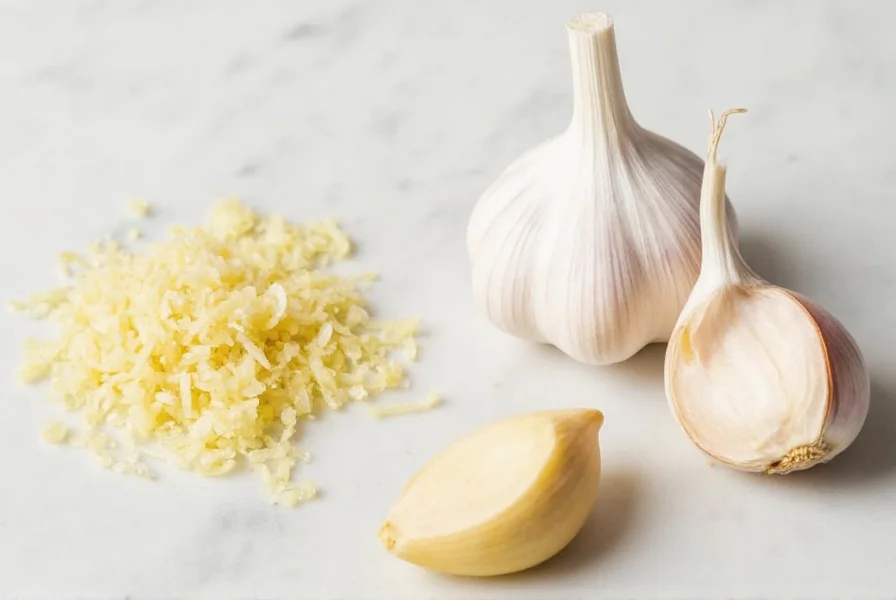Understanding garlic measurements is essential for achieving perfect flavor balance in your cooking. Whether you're following a recipe that specifies minced garlic or working with whole cloves, knowing the precise conversion prevents under-seasoning or overpowering your dishes.
Garlic Clove to Minced Garlic Conversion Guide
The exact amount of minced garlic you'll get from a single clove depends primarily on its size and your mincing technique. Here's a detailed breakdown of measurements for different clove sizes:
| Garlic Clove Size | Whole Clove Weight | Minced Garlic Yield |
|---|---|---|
| Small | 3-5 grams | 1/4 teaspoon (1.25 ml) |
| Medium (standard) | 6-9 grams | 1/2 teaspoon (2.5 ml) |
| Large | 10-14 grams | 3/4 teaspoon (3.75 ml) |
| Jumbo | 15+ grams | 1 teaspoon (5 ml) |
Factors Affecting Minced Garlic Measurements
Several variables influence how much minced garlic you'll obtain from a single clove:
Clove Size Variability
Garlic cloves vary significantly in size depending on the variety and growing conditions. Hardneck varieties typically produce larger cloves than softneck varieties. When recipes call for "one clove" without specification, they generally mean a medium-sized clove.
Mincing Technique Matters
Your mincing method affects the final volume:
- Knife-minced: Yields slightly more volume due to small air pockets between irregular pieces
- Garlic press: Produces denser minced garlic, potentially yielding 10-15% less volume
- Food processor: Creates the most compact minced garlic, reducing volume by up to 20%

Practical Cooking Applications
Knowing how much minced garlic in a clove helps you adapt recipes successfully. Consider these practical scenarios:
When Precision Counts
For delicate sauces, dressings, and baking applications where garlic flavor must be precisely balanced, use measuring spoons for minced garlic. In these cases, understanding how many teaspoons of minced garlic per clove prevents overpowering subtle flavors.
When Approximation Works
For heartier dishes like stews, roasts, and stir-fries, the exact measurement matters less. Chefs often use the "smell test"—adding minced garlic until the aroma reaches the desired intensity. This approach works well when considering how much minced garlic equals one clove in robust recipes.
Common Measurement Mistakes to Avoid
Many home cooks make these errors when converting garlic cloves to minced measurements:
Overpacking the Spoon
When measuring minced garlic, don't press it tightly into the spoon. Lightly fill the measuring spoon and level it off for accurate results. Overpacking can increase the amount by 25-30%, dramatically altering your recipe's flavor profile.
Ignoring Garlic Age
Older garlic cloves contain less moisture and may yield slightly less minced volume than fresh cloves. When determining how much minced garlic from one clove, factor in garlic freshness for the most accurate measurement.

Garlic Substitution Tips
Running out of fresh garlic? Here's how to substitute other garlic forms while maintaining proper flavor balance:
- Dried garlic flakes: 1 clove ≈ 1/8 teaspoon flakes (reconstitute with water for best results)
- Garlic powder: 1 clove ≈ 1/16 teaspoon powder (use sparingly—it's more potent)
- Bottled minced garlic: 1 clove ≈ 1/2 teaspoon (check label as preservatives affect potency)
- Garlic paste: 1 clove ≈ 1/4 teaspoon (more concentrated than freshly minced)
Storing Minced Garlic Properly
If you've minced more garlic than needed for your recipe, proper storage maintains quality:
- Refrigerate in an airtight container for up to 1 week
- Freeze in ice cube trays with olive oil for up to 6 months
- Never store minced garlic in oil at room temperature (botulism risk)
Frequently Asked Questions
How much jarred minced garlic equals one fresh clove?
Most commercial jarred minced garlic products are more concentrated than freshly minced garlic. Generally, 1/3 teaspoon of bottled minced garlic equals one medium fresh clove. Always check the product label as concentrations vary between brands.
Does roasting garlic change the minced measurement?
Yes, roasting reduces garlic's volume by about 25% due to moisture loss. One roasted medium clove yields approximately 3/8 teaspoon of minced garlic rather than the standard 1/2 teaspoon. Account for this when following recipes that specify raw garlic measurements.
How can I quickly mince garlic without a press?
Place the clove on a cutting board, lay the flat side of a chef's knife over it, and press down firmly with your palm to crush it. This loosens the skin and makes mincing easier. Then rock the knife back and forth over the garlic until finely minced. Sprinkling a pinch of salt helps prevent sticking and creates a finer mince.
Why does my minced garlic measurement differ from recipe expectations?
Measurement variations occur due to clove size differences, mincing technique, and garlic variety. Recipes typically assume medium-sized cloves. If your garlic is particularly large or small, adjust accordingly. Also, tightly packed minced garlic can contain up to 30% more volume than loosely filled measurements.
Can I use garlic powder instead of minced garlic?
Yes, but use caution—garlic powder is significantly more concentrated. Substitute 1/8 teaspoon garlic powder for one medium clove of minced garlic (1/2 teaspoon). Remember that powder lacks the fresh flavor complexity and moisture content of minced garlic, so it works best in dry rubs or when moisture isn't critical to the recipe.











 浙公网安备
33010002000092号
浙公网安备
33010002000092号 浙B2-20120091-4
浙B2-20120091-4